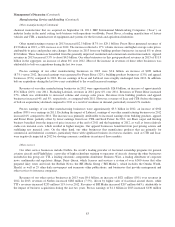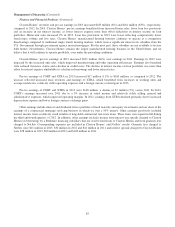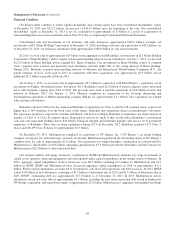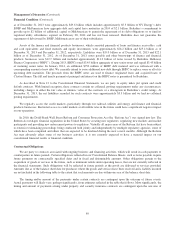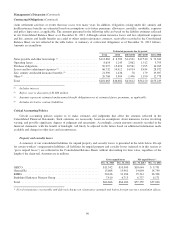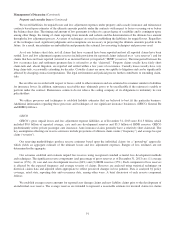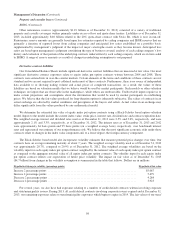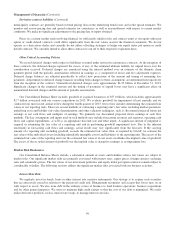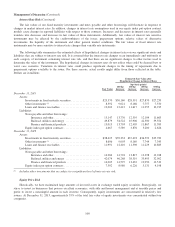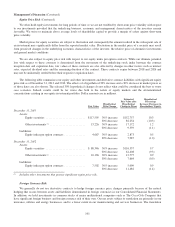Berkshire Hathaway 2013 Annual Report Download - page 94
Download and view the complete annual report
Please find page 94 of the 2013 Berkshire Hathaway annual report below. You can navigate through the pages in the report by either clicking on the pages listed below, or by using the keyword search tool below to find specific information within the annual report.Management’s Discussion (Continued)
Property and casualty losses (Continued)
GEICO (Continued)
when adjusters have insufficient time and information to make specific claim estimates and for a large number of minor
physical damage claims that are paid within a relatively short time after being reported. Average reserve amounts are driven by
the estimated average severity per claim and the number of new claims opened.
Our claims adjusters generally establish individual liability claim case loss and loss adjustment expense reserve estimates
as soon as the specific facts and merits of each claim can be evaluated. Case reserves represent the amounts that in the judgment
of the adjusters are reasonably expected to be paid in the future to completely settle the claim, including expenses. Individual
case reserves are revised over time as more information becomes known.
For most liability coverages, case reserves alone are an insufficient measure of the ultimate cost due in part to the longer
claim-tail, the greater chance of protracted litigation and the incompleteness of facts available at the time the case reserve is
established. Therefore, we establish additional case development reserve estimates, which are usually percentages of the case
reserve. As of December 31, 2013, case development reserves averaged approximately 25% of total established case reserves. In
general, case development factors are selected by a retrospective analysis of the overall adequacy of historical case reserves.
Case development factors are reviewed and revised periodically.
For unreported claims, IBNR reserve estimates are calculated by first projecting the ultimate number of claims expected
(reported and unreported) for each significant coverage by using historical quarterly and monthly claim counts to develop age-
to-age projections of the ultimate counts by accident quarter. Reported claims are subtracted from the ultimate claim projections
to produce an estimate of the number of unreported claims. The number of unreported claims is multiplied by an estimate of the
average cost per unreported claim to produce the IBNR reserve amount. Actuarial techniques are difficult to apply reliably in
certain situations, such as to new legal precedents, class action suits or recent catastrophes. Consequently, supplemental IBNR
reserves for these types of events may be established through the collaborative effort of actuarial, claims and other management
personnel.
For each significant coverage, we test the adequacy of the total loss reserves using one or more actuarial projections based
on claim closure models, paid loss triangles and incurred loss triangles. Each type of projection analyzes loss occurrence data
for claims occurring in a given period and projects the ultimate cost.
Unpaid loss and loss adjustment expense estimates recorded at the end of 2012 developed downward by $238 million when
reevaluated through December 31, 2013, producing a corresponding increase to pre-tax earnings in 2013. These downward
reserve developments represented approximately 1.3% of earned premiums in 2013 and approximately 2.3% of prior year-end
recorded liabilities. Reserving assumptions at December 31, 2013 were modified appropriately to reflect the most recent
frequency and severity results. Future reserve development will depend on whether actual frequency and severity are more or
less than anticipated.
Within the automobile line of business, reserves for liability coverages are more uncertain due to the longer claim-tails.
Approximately 92% of GEICO’s reserves as of December 31, 2013 were for automobile liability, of which bodily injury (“BI”)
coverage accounted for approximately 55%. We believe it is reasonably possible that the average BI severity will change by at
least one percentage point from the severity used. If actual BI severity changes one percentage point from what was used in
establishing the reserves, our reserves would develop up or down by approximately $165 million resulting in a corresponding
decrease or increase in pre-tax earnings. Many of the same economic forces that would likely cause BI severity to be different
from expected would likely also cause severities for other injury coverages to differ in the same direction.
GEICO’s exposure to highly uncertain losses is believed to be limited to certain commercial excess umbrella policies
written during a period from 1981 to 1984. Remaining liabilities associated with such exposure are currently a relatively
insignificant component of GEICO’s total reserves (approximately 1.3%) and there is minimal apparent asbestos or
environmental liability exposure. Related claim activity over the past year was insignificant.
92



